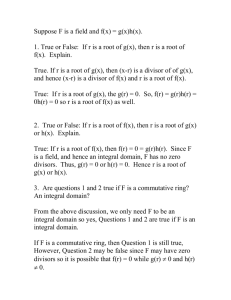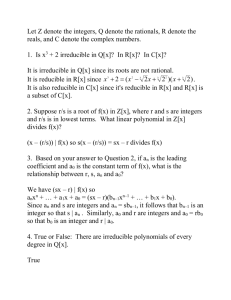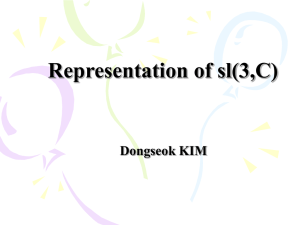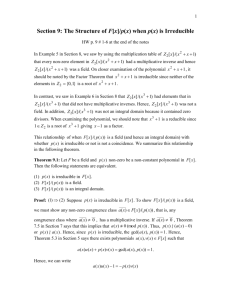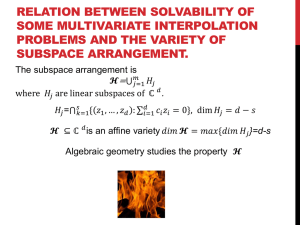Decomposition Theory of a Certain Class of ( )
advertisement
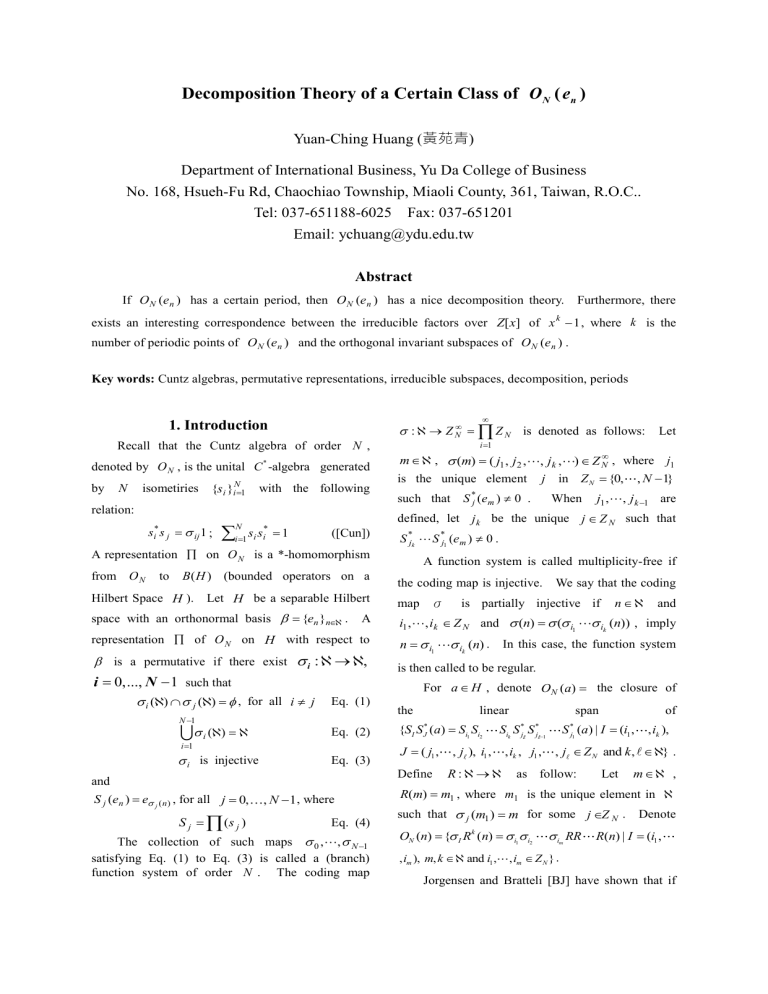
Decomposition Theory of a Certain Class of O N ( en )
Yuan-Ching Huang (黃苑青)
Department of International Business, Yu Da College of Business
No. 168, Hsueh-Fu Rd, Chaochiao Township, Miaoli County, 361, Taiwan, R.O.C..
Tel: 037-651188-6025 Fax: 037-651201
Email: ychuang@ydu.edu.tw
Abstract
If O N (e n ) has a certain period, then O N (e n ) has a nice decomposition theory.
Furthermore, there
exists an interesting correspondence between the irreducible factors over Z[x] of x k 1 , where k is the
number of periodic points of O N (e n ) and the orthogonal invariant subspaces of O N (e n ) .
Key words: Cuntz algebras, permutative representations, irreducible subspaces, decomposition, periods
1. Introduction
Recall that the Cuntz algebra of order N ,
denoted by O N , is the unital C * -algebra generated
by
N
isometiries {si }iN1
with the following
relation:
si* s j ij 1 ;
N
s s*
i 1 i i
1
to
B(H ) (bounded operators on a
Hilbert Space H ).
Let H be a separable Hilbert
space with an orthonormal basis {en }n .
A
representation of O N on H with respect to
is a permutative if there exist i : ,
i 0,..., N 1 such that
i () j () , for all i j
m , (m) ( j1 , j2 ,, jk ,) Z N , where j1
is the unique element j in Z N {0, , N 1}
such that
S *j (em ) 0 .
When
j1 , , j k 1 are
S *jk S *j1 (em ) 0 .
A function system is called multiplicity-free if
the coding map is injective.
map σ
We say that the coding
is partially injective if
n
and
i1 ,, ik Z N and (n) ( i1 ik (n)) , imply
n i1 ik (n) . In this case, the function system
is then called to be regular.
For a H , denote ON (a) the closure of
Eq. (1)
N 1
i ()
Eq. (2)
i is injective
Eq. (3)
i 1
the
linear
{SI S (a) Si1 Si2
*
J
J ( j1 ,
Define
and
S j (en ) e j ( n) , for all j 0, , N 1, where
S j (s j )
Let
i 1
defined, let j k be the unique j Z N such that
([Cun])
A representation on O N is a *-homomorphism
from O N
: Z N Z N is denoted as follows:
Eq. (4)
The collection of such maps 0 ,, N 1
satisfying Eq. (1) to Eq. (3) is called a (branch)
function system of order N . The coding map
span
*
j
Sik S S
, j ), i1 ,
R :
, ik , j1 ,
of
S (a) | I (i1 ,
*
j 1
*
j1
, ik ),
, j Z N and k , } .
as follow:
Let
m ,
R(m) m1 , where m1 is the unique element in
such that j (m1 ) m for some j Z N .
ON (n) { I R (n) i1 i2
k
, im ), m, k and i1 ,
i RR
m
Denote
R(n) | I (i1 ,
, im Z N } .
Jorgensen and Bratteli [BJ] have shown that if
the function system { j } jZ N
is regular then
O N (e n ) , for all n is an irreducible invariant
subspace
of
the
corresponding
representation on O N .
permutative
That is to say, if the
function system is regular, then the decomposition
theory of is completely known.
they showed that when
Furthermore,
is regarded as a
contradiction.
Since
Q1 {a1 , , a k } .
cm
cim ei
Let
, where
iQm
a1 Q1 , we have
m 2 be given, put
Qm
and
cim 0 ,
i Qm . For this m , find p(m) Qm . Then
there exist I p (m ) and J p (m) such that
S I p ( m) S J* p ( m) (e1 ) e p(m)
representation of UHF N , then without assuming
SI p ( m ) S J*p ( m ) (c1 ) m cm a linear combination of
regularity, UHF N (en ) the closure of the linear
{c j } j , where m C
span {S I S J* (en ) | I (i1 ,
| Q1 || Qm |
i1 ,
, ik , j1 ,
, ik ), J ( j1 ,
, jk ), k ,
, jk Z N }
But, we also have
( UHF N is the uniform hyperfinite algebra of order
N ) is invariant and irreducible for all n .
In [Hua], it is shown that if K ON (en ) is a
S J p ( m) S I*p ( m) (e p(m) ) e1
S J p ( m ) SI*p ( m ) (cm ) m c1 a linear combination of
where m C
proper invariant subspace of O N with a reduced
{c j } j ,
basis (Definition 6, [Hua]) then ON (n) possesses a
| Qm || Q1 |
period.
Eqs.
develop
(Theorem 9, [Hua]).
the
In this paper, we will
decomposition
between
invariant
subspaces of an O N ( en ) with a certain period and
an
interesting
Eq. (5)
connection
between
(5)
cm
1
m
Eq. (6)
and
(6)
imply
| Q1 || Qm | ;
hence
S I p ( m ) S J* p ( m ) (c1 ) . So the proof is complete.
invariant
Q.E.D.
subspaces of O N and the irreducible factors p (x)
Our next goal is to find the decomposition
over Z [x] of x k 1 0 , where k is the number
theory for such a reducible O N (e n ) .
of periodic points. (Definition 6, [Hua]).
Before going
to the theoretical proof, let us look at an example.
2. Main Results
Proposition 1 Suppose O N ( en ) is reducible with
Suppose there exist a1 , a 2 , a3 , a 4 ON (n) such that
a proper subspace K and there is a j0 such that
some j0 Z N .
j0 (ai ) ai 1 ,
1 i k 1
S j0 (ai ) ai 1 , i 1, 2,3
and (a k ) a1 ,
and
S j0 (a4 ) a1
for
We claim that
K1 ON (ea1 ea2 ea3 ea4 )
then K ON (1en1 en ) for some ,
K 2 ON (ea1 ea2 ea3 ea4 )
i C, i {1, , } , and {n1 , , n } {a1 , , ak } .
K3 ON (ea1 ea3 ),
and
K 4 ON (ea1 ea3 )
Proof: Let {ci }i be a reduced basis for K ,
where ci (c1i , c 2i , , c mi , ) .
be an i0 such that
i
c a0
1
Since there must
0 , without loss of
generality, we assume i0 1 .
Let c1
c1j e j
are proper invariant subspaces of O N (e n ) .
In
order to see K 2 is proper it suffices to show that
,
H 2 span{S mj0 (ea1 ea2 ea3 ea4 ) | m 0,1,2,3} is a
We claim
proper subspace of K span{ea1 , ea2 , ea3 , ea4 } C 4 .
( j ) (i), i, j Q1 . If not, then there exists a
But it is easy to see that H 2 is the 1-dimensional
finite string L such that S L* (ei ) 0 S L* (e j ) .
space
where Q1 , and c1j 0, j Q1 .
jQ1
Observe that S L S L* (C1 ) C1 , which leads to a
of
K
generated
ea1 ea2 ea3 ea4 .
by
Similarly,
the
vector
dim H 1 1 ,
dim H 3 2
,
dim H 4 2
and
,
where
H i span{S (bi ) | m 0,1, 2,3}, i 1,3, 4 , b1 ea1
m
j0
k
K 0 {S mj0 ( xi eai ) | m 0,1, , k 1} is a proper
i 1
ea2 ea3 ea4 , b3 ea1 ea3 , and b4 ea1 ea3 .
subspace of H 0 .
Furthermore, it is not hard to see that K 4 is the
the K 0 such that dim K 0 1 which implies that
orthogonal complement of K 3 , K1 K 2 K 4 and
K 0 is irreducible.
K 1 is actually the orthogonal complement of K 2 in
have
the
subspace
Hence K K4 K3
K4 .
K1 K2 K3 with K 1 , K 2 , and K 3 pairwisely
The idea of the proof is to find all
Suppose dim K 0 1 , then we
k
k
i 1
i 1
S j0 ( xi eai ) ( xi eai )
Moreover, there is an interesting
x j x j 1 , j 2,
, k and x1 xk
correspondence between K 1 , K 2 , K 3 and the
x2 x1 , x3 2 x1 ,
, xk k 1 x1 , x1 k x1
irreducible factors of x 4 1 in Z[x] .
k 1 (Since x1 0)
orthogonal.
x 4 1 ( x 1)( x 1)( x 2 1)
so we conclude that if is a k th root of unity,
We make the following correspondence
K ON (i 1 i 1eai )
k
K1 x 1 p1 ( x)
then
K 2 x 1 p 2 ( x)
subspace.
K 3 x 2 1 p3 ( x)
K K ' {0} if and ' are disjoint k th
with dim( K i ) deg( pi ( x)) .
Now
it
root of unity since
Later on, we will show that in general there is
is
is an irreducible
easy
to
see
0
.
1
0
'
( ' )
such correspondence between the irreducible factors
1 dim( K ) k dim H 0
of x k 1 in Z[x] and some special invariant
k 1 K ON (en ) .
k
that
Because
, we conclude that
Q.E.D.
subspaces of O N (e n ) .
It is obvious that K 1 and K 2 are irreducible,
but is K 3 irreducible?
The answer is no, and we
introduce the following theorem that decomposes
O N (e n ) into irreducibles.
Theorem 2
The next result carries out our earlier promise.
Corollary 3
{a1 , a 2 , , ak }
i 1,
Suppose O N (e n ) is reducible with
Let O N (e n ) be reducible with period
p1 ( x)
, k 1 ,
pr ( x)
and
j0 (ai ) ai 1
j0 (ak ) a1 .
,
If xk 1
where pi (x) is irreducible over
period
{a1 , a 2 , , a k } ,
and
j0 (ai ) ai 1 ,
Z[ x] , then each pi (x) corresponds to a proper
i 1,
, k 1 , j0 (ak ) a1 .
Then, O N (e n )
invariant subspace
K i ON ( x ij ea j )
decomposes into k disjoint irreducible subspaces as
follow:
where
O N (e n ) k 1 O N (e a1 e a2
Proof:
jQi
Let
k 1
e ai1 ) .
H 0 span{ea1 , , eak } C k .
Qi {1,2,, k} ,
x ij 1 ,
j Qi .
r
Furthermore, Ki K j , i j, and ON (en ) Ki .
i 1
In
Proof:
k
order to show that K 0 O N ( xi eai ) , xi C is a
i 1
proper subspace of H 0 , it suffices to show that
For i {1, 2,
pi (x) be {i ,1 , i ,2 ,
ni
k
j 1
1
, r} , let the complex roots of
, i ,ni } . Define
K i O N ( ( i , j ) 1 ea ) O N ( x ij ea j )
jQi
where Qi {1,2,, k} , x ij 0 , j Qi .
Then
dim( K i ) ni deg( pi )
and
xij 1
since the
coefficients of pi ( x) are either 1 or -1. To show
that K i K j , i j , it suffices to show that if
x 1 p ( x) q ( x ) , where p( x), q( x) Z[ x] , then
k
the corresponding subspaces
orthogonal.
Kp
and
Kq
are
Now
k
O ( a
p ( a ) 0
Kp
N
1
ea ) , K q
1
k
O (
q( )0
N
j 1
j 1
k 5 , x5 1 ( x 1)( x 4 x3 x 2 x 1)
x 1 ON (a1 a2 a3 a4 )
x 4 x3 x 2 x 1 ON (a1 a2 ) .
k 6 , x 6 1 ( x 1)( x 1)( x 2 x 1)( x 2 x 1)
x 1 ON (a1 a2 a3 a4 a5 a6 )
x 1 ON (a1 a2 a3 a4 a5 a6 )
ea j ) .
x 2 x 1 ON (a1 a2 2 a3 a4 a5 2 a6 )
ON (a1 a2 a4 a5 )
Consider
k
( a
1
1
k
ea ,
j 1
j 1
where is a complex root of x3 1 .
ea j )
1 ( ) ( ) 2
x 2 x 1 ON (a1 1a2 12 a3
( ) k 1
is a k -th root of unity, Eq. (7) is 0 unless .
By the complex conjugate root theorem, we know
that is also a root of q( x) 0 ; hence cannot
be a root or p( x) 0 ; so .
since
k i 1 deg( pi ),
r
decompose.
ON (a1 2 a2 22 a3 25 a6 )
Eq.(7)
It suffices to show that Eq. (7) is 0, for all ,
such that p( ) 0 and q( ) 0 . Since
Furthermore,
i 1,
the Ki 's,
Hence the proof is complete.
, r,
Q.E.D.
15 a6 )
ON (a1 a2 a4 a5 )
where 1 and i
3
i
is a complex number,
i 1, 2 .
The case k 7 is similar to the case k 3 .
In
fact,
if
k a
( x 1)( x k 1 x k 2
is
prime,
then x7 1
1) is the factorization over
Z[ x] ; hence they are all similar.
k 8 , x8 1 ( x 1)( x 1)( x 2 1)( x 4 1)
The
following
example
shows
the
correspondence between irreducible factors of x k 1
x 1 ON (a1 a2
a8 )
x 1 ON (a1 a2 a3 a4
a7 a8 )
in Z[ x] and orthogonal invariant subspaces of some
x 2 1 ON (a1 a3 a5 a7 )
special cases.
x 4 1 ON (a1 a5 ) .
Example 4
k 2 , x 2 1 ( x 1)( x 1)
x 1 ON (a1 a2 )
x 1 ON (a1 a2 ) .
k 3 , x3 1 ( x 1)( x 2 x 1)
x 1 ON (a1 a2 a3 )
x 2 x 1 ON (a1 a2 ) ON (a2 a3 ) ON (a3 a1 )
and
k 9 , x9 1 ( x 1)( x 2 x 1)( x 6 x3 1)
x 1 ON (a1 a2
a9 )
x 2 x 1 ON (a1 a2 a3 a4 a7 a8 )
x 6 x 3 1 ON (a1 a4 ) .
k 10 , x10 1 ( x 1)( x 4 x3 x 2 x 1)
( x 1)( x 4 x3 x 2 x 1)
x 1 ON (a1 a2
a10 )
x 1 ON (a1 a2 a3 a4
a9 a10 )
ON (a1 a2 ) ON (a1 a2 2 a3 )
x 4 x3 x 2 x 1 ON (a1 a2 a6 a7 )
ON (a1 2 a2 a3 ) , where is a complex root of
x 4 x3 x 2 x 1 ON (a1 a2 a6 a7 ) .
x3 1 0 .
k 4 , x 4 1 ( x 1)( x 1)( x 2 1)
x 1 ON (a1 a2 a3 a4 )
x 1 ON (a1 a2 a3 a4 )
x 2 1 ON (a1 a3 ) .
A Remark on UHFN
If is a permutative representative of ON
on H , then there is a natural way to view as a
representation of UHFN .
relation on by
Define an equivalence
n m S I S J* (en ) em , for some finite string I , J
with | I || J | .
is the decomposition into UHFN - irreducibles.
Theorem 2.7 in [BJ2] shows that
References
given n ,
[BJ] O. Bratteli and P. E. T. Jorgensen, “Iterated
ON (en ) UHFN (em )
m
is
the
decomposition
of
Function
into
ON (en )
UHFN - irreducible, where m runs through all the
equivalent class in ON (en ) .
The sum is finite if
and only if there is an a ON (en ) such that
I (a) a for some finite I . Suppose ON (en ) is
ON - reducible with a period {a1 ,
, ak } such that
S j0 (ai ) ai 1 , S j0 (ak ) a1 , for some j0 Z N . By
Theorem 2,
ON (en ) (a1 a2
ak ) .
k 1
k 1
Systems
and
Permutative
Representations of the Cuntz Algebra”, Mem.
Amer. Math. Soc. 139 (1999) no. 663.
[Cun] J. Cuntz, “ C * -Algebra
Gemerated by
Isometries”, Comm. Math. Phys., 57 (1977),
173-185.
[DaPi] K. Davidson and D. R. Pitts, “Invariant
Subspaces
and
Hyper-reflexivity
for
Free
Semigroup Algebras”, Proc. London Math. Soc.
78 (1999), 401-430.
We claim that
UHFN (a1 a2
[Hua]
k 1ak )
ON (a1 a2
UHFN (a1 a2
Representation of
k 1ak )
for all k - th root of unity .
I (i1 ,
J ( j1 ,
[Tak] M. Takesaki, “Theory of Operator Algebras I”,
Springer-Verlag, New York-Heidelberg-Berlin,
, jq ) .
Firstly, note that
(S j0 )m (a1 a2
k 1ak )
m (a1 a2
k 1ak ) .
Suppose q p , then let I 0 ( j0 , j0 ,
b S I S (a1 a2
*
J
k 1
q p S I S J*0 (a1 a2
, j0 )
ak )
S I S J* ( q p S I0 (a1 a2
k 1ak ))
k 1ak )
where J 0 is some finite string with J 0 p I .
Similarly, if q p , then we can find I 0 such that
I 0 J with
b SI0 S J* (a1 a2
for some
k 1ak )
Z . This shows that
UHFN (a1 a2
k 1ak )
ON (a1 a2
k 1ak ) .
Hence
ON (en ) UHFN (a1 a2
1
k
k 1ak )
O N ”, Yu-Da Academic
Soc., (1997).
k 1ak )
, ip ) ,
Permutative
of the Theory of Operator Algebras”, Amer. Math.
k 1ak ) .
To show the others direction, let
be given, where
”On
[KaRi] R. Kadison and J.R. Ringrose, “Fundamentals
k 1ak )
b S I S J* (a1 a2
Huang,
Journal, Vol. 9, (2005) 283-290.
It is trivial that
ON (a1 a2
Yuan-Ching
(1979).
